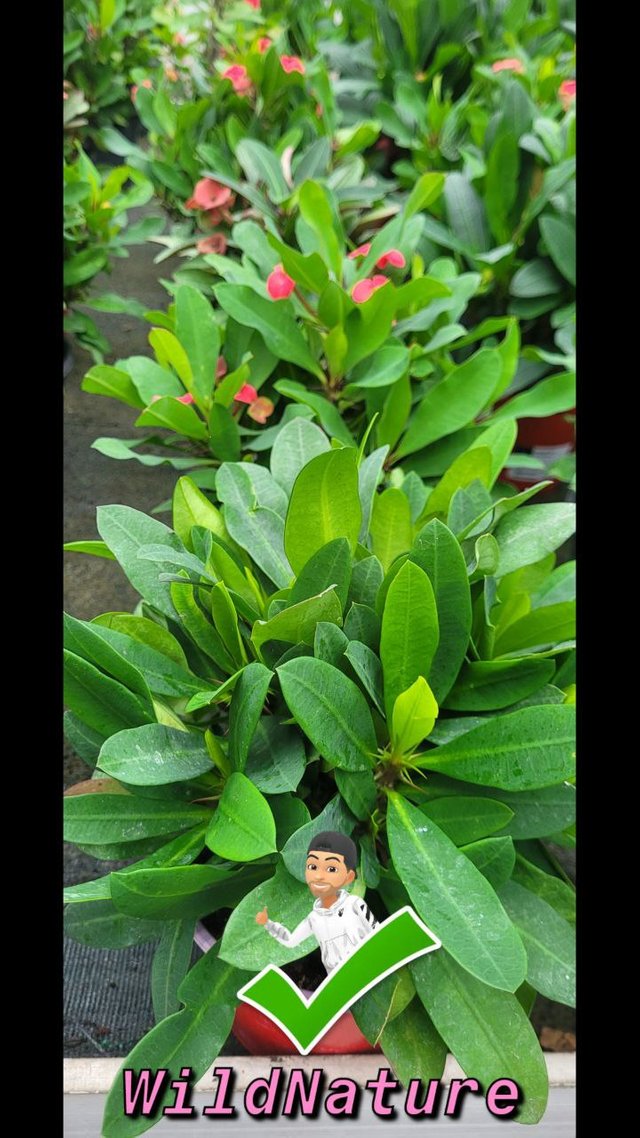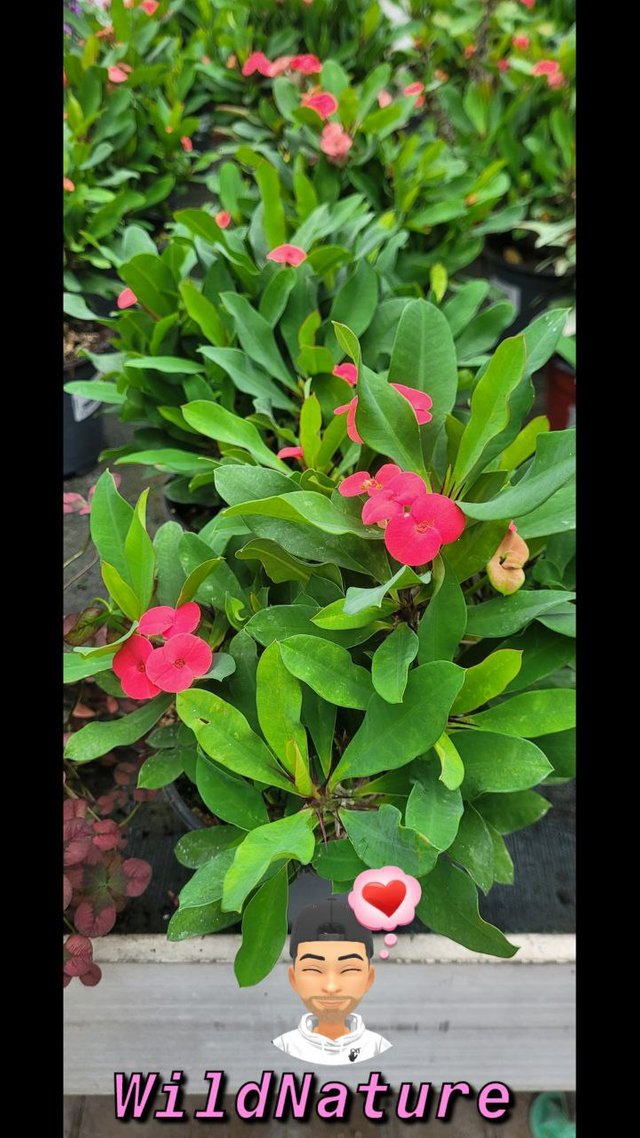The English version follows in the end.
Versione Italiana 🇮🇹🇮🇹🇮🇹

L’Euforbia milii, comunemente conosciuta come "corona di spine", è una pianta grassa appartenente alla famiglia delle Euphorbiaceae. Originaria del Madagascar, questa pianta è molto apprezzata come ornamentale, sia per la sua rusticità che per la capacità di produrre fiori vivaci praticamente tutto l’anno, soprattutto in condizioni climatiche favorevoli.
L’Euforbia milii si presenta come un arbusto ramificato, che può raggiungere un’altezza di circa un metro, anche se coltivata in vaso rimane generalmente più contenuta. I suoi fusti sono legnosi alla base, mentre la parte superiore è caratterizzata da rami spinosi, da cui deriva il suo nome comune. Le spine fungono da protezione naturale, mentre le foglie, di colore verde chiaro, sono disposte in modo alterno e si trovano prevalentemente sulle parti più giovani dei rami.
I fiori, piccoli e poco appariscenti, sono circondati da vistose brattee colorate che variano dal rosso al rosa, dal giallo al bianco. Queste brattee, spesso scambiate per i veri petali, sono la principale attrazione ornamentale della pianta. La fioritura è continua nelle giuste condizioni ambientali.

Per quanto riguarda la coltivazione, predilige esposizioni luminose e soleggiate, essenziali per stimolare una fioritura abbondante. Tollera bene la siccità grazie alla sua natura succulenta, ma è importante evitare ristagni d’acqua per prevenire marciumi radicali. Il substrato ideale è leggero, ben drenante e arricchito con sabbia o perlite. Durante l’estate, le annaffiature devono essere moderate, attendendo che il terreno si asciughi completamente tra un’irrigazione e l’altra; in inverno, le irrigazioni vanno ulteriormente ridotte.
L’Euforbia milii è resistente al caldo e sopporta temperature elevate, ma teme il freddo intenso e le gelate: nei climi più rigidi è consigliabile coltivarla in vaso per poterla riparare durante l’inverno. Attenzione alla linfa lattiginosa della pianta, che è tossica e irritante per la pelle e le mucose; è quindi consigliabile maneggiarla con guanti.
Oltre alla sua bellezza ornamentale, l’Euforbia milii ha un forte valore simbolico in diverse culture: è associata alla passione e alla protezione, probabilmente per via delle spine che ricordano la corona di Cristo.
E voi, avete mai coltivato un’Euforbia milii? Cosa ne pensate di questa pianta? Fatemelo sapere nei commenti e lasciate un "like" se apprezzate questa pianta! 👍🌵🌸✨
(Foto scattate da me) 📸
English version 🇬🇧🇬🇧🇬🇧

The Euphorbia milii, commonly known as the "crown of thorns," is a succulent plant belonging to the Euphorbiaceae family. Native to Madagascar, this plant is highly valued as an ornamental species, both for its resilience and its ability to produce vibrant flowers almost year-round, especially in favorable climates.
Euphorbia milii grows as a branched shrub that can reach a height of about one meter, although it remains more compact when cultivated in pots. Its stems are woody at the base, while the upper sections feature spiny branches, giving rise to its common name. The spines provide natural protection, while the light green leaves are alternately arranged and primarily grow on the younger parts of the branches.
The flowers, small and not particularly showy, are surrounded by colorful bracts that range from red to pink, yellow, and white. These bracts, often mistaken for petals, are the plant’s main ornamental feature. Flowering is continuous under the right environmental conditions.

In terms of cultivation, Euphorbia milii thrives in bright, sunny locations, which are essential to encourage abundant flowering. It tolerates drought well due to its succulent nature, but it is crucial to avoid waterlogging to prevent root rot. The ideal substrate is light, well-draining, and enriched with sand or perlite. During summer, watering should be moderate, allowing the soil to dry out completely between waterings; in winter, watering should be further reduced.
Euphorbia milii is heat-tolerant and thrives in high temperatures but is sensitive to extreme cold and frost. In regions with harsh winters, it is advisable to grow it in a pot so it can be sheltered during the colder months. Be cautious with the plant’s milky sap, which is toxic and can irritate the skin and mucous membranes; handling it with gloves is recommended.
Beyond its ornamental appeal, Euphorbia milii holds strong symbolic value in various cultures. It is often associated with passion and protection, likely due to the resemblance of its spines to the crown of thorns of Christ.
Have you ever grown a Euphorbia milii? What do you think of this plant? Let me know in the comments, and leave a "like" if you appreciate this unique species! 👍🌵🌸✨
(Photos taken by me) 📸
Sicuramente è la prima volta che sento il nome di euforbia milii... non sarei però così sicuro che sia la prima volta che la vedo. Ottima pianta... le sue spine mi sembrano uno strumento di protezione per proteggere della sua delicatezza.
Downvoting a post can decrease pending rewards and make it less visible. Common reasons:
Submit
L’Euforbia milii è una pianta che molti hanno visto senza conoscerne il nome. Le sue spine non solo proteggono la pianta, ma creano un contrasto interessante con i suoi fiori. 😁
Grazie per il tuo commento 🙏
Downvoting a post can decrease pending rewards and make it less visible. Common reasons:
Submit
Grazie a te per questa precisazione
Downvoting a post can decrease pending rewards and make it less visible. Common reasons:
Submit
Downvoting a post can decrease pending rewards and make it less visible. Common reasons:
Submit